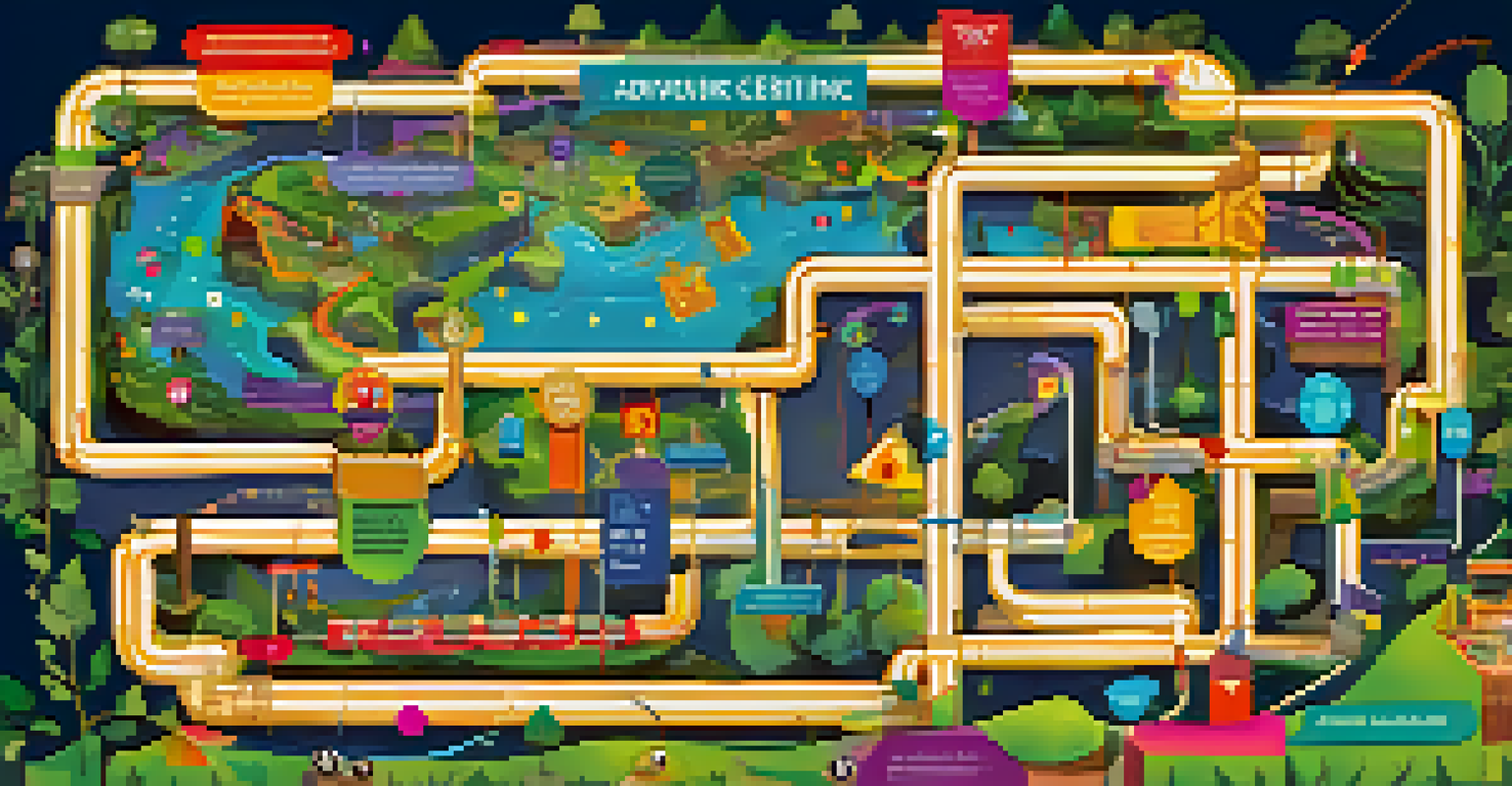Implementing Gamification in Online Learning Platforms Effectively

Understanding Gamification and Its Benefits in Learning
Gamification refers to the application of game-like elements in non-game contexts, such as education. By incorporating features like points, badges, and leaderboards, online learning platforms can enhance engagement and motivation among learners. This approach taps into the natural desire for achievement and competition, making the learning experience more enjoyable.
Gamification is the application of game elements and principles in non-game contexts to engage users and solve problems.
When students encounter challenges in a gamified environment, they are often more willing to persevere, as they can see tangible rewards for their efforts. This not only boosts retention rates but also fosters a sense of accomplishment. Furthermore, gamification can cater to various learning styles, ensuring that a diverse group of learners can benefit.
In essence, gamification transforms traditional learning methods into interactive experiences that encourage participation. By making learning more dynamic, platforms can create a community of motivated learners who are eager to reach their educational goals.
Identifying Key Gamification Elements for Your Platform
To successfully implement gamification, it's vital to identify which elements will resonate with your audience. Common features include progress tracking, rewards systems, and social interaction tools. Understanding the specific needs and preferences of your learners can guide you in selecting the most effective elements.

For instance, some learners may thrive on competition and enjoy leaderboards, while others may prefer collaborative challenges. Offering a mix of individual and group activities can cater to different motivations and create a more inclusive learning environment. The key is to strike the right balance between competition and cooperation.
Gamification Boosts Learning Engagement
Incorporating game-like elements such as points and badges in education enhances motivation and creates a more enjoyable learning experience.
By thoughtfully incorporating these elements, online learning platforms can create a tailored experience that encourages engagement and sustains interest over time. This approach not only enhances learning outcomes but also fosters a sense of community among participants.
Designing Engaging Learning Pathways with Gamification
Creating structured learning pathways is essential for guiding learners through their educational journey. By integrating gamification into these pathways, you can make the process more interactive and enjoyable. Think of it as designing a quest, where each module or lesson acts as a level that learners must complete to progress.
Games are the most elevated form of investigation.
Incorporating challenges and rewards at each stage can motivate learners to continue advancing. For example, unlocking new content upon completing a module can create excitement and anticipation. This clear sense of progression not only boosts motivation but also helps learners visualize their achievements.
Additionally, incorporating feedback mechanisms, such as instant results on quizzes, can enhance the learning experience. This allows learners to reflect on their performance and make adjustments, further deepening their understanding of the material.
Creating a Reward System that Motivates Learners
A well-designed reward system is a cornerstone of effective gamification. Rewards can come in various forms, such as points, badges, or even certificates of completion. Each type of reward serves a different purpose, whether it’s to recognize effort, celebrate milestones, or incentivize further learning.
For example, offering badges for completing specific skills or reaching certain levels can provide learners with a sense of achievement. This not only boosts their confidence but also encourages them to strive for more. The feeling of accomplishment can be a powerful motivator, driving learners to engage more deeply with the material.
Tailor Strategies for Diverse Audiences
Understanding the unique preferences and motivations of different learner demographics is essential for effectively implementing gamification.
It’s important to ensure that the rewards are meaningful and tied to the learning objectives. When learners see a direct connection between their efforts and the rewards they receive, they are more likely to stay engaged and motivated throughout their educational journey.
Integrating Social Features to Enhance Engagement
Social interaction is a crucial component of gamification in online learning. Integrating features such as discussion forums, group challenges, or peer reviews can create a sense of community among learners. This camaraderie can significantly enhance motivation, as learners feel supported by their peers.
For instance, facilitating team-based projects or challenges can encourage collaboration and friendly competition. When learners work together towards a common goal, they not only build relationships but also deepen their understanding of the material through shared insights. This social aspect can make learning feel less isolating.
Moreover, incorporating social sharing features, such as the ability to showcase achievements on social media, can extend engagement beyond the platform itself. This not only celebrates learners’ accomplishments but also promotes the platform to potential new users through organic word-of-mouth.
Measuring Success: Tracking Engagement and Outcomes
To understand the effectiveness of your gamification strategies, it's essential to implement robust tracking measures. Monitoring engagement metrics, such as participation rates and completion times, can provide valuable insights into how learners are responding to gamified elements. This data helps identify what works and what may need adjustment.
Additionally, assessing learning outcomes is crucial in determining the impact of gamification on knowledge retention and skill acquisition. Regular assessments can help gauge whether the gamified approach is meeting educational goals. If learners are excelling, it’s a strong indicator that your strategy is effective.
Future Tech Enhances Gamification
Emerging technologies like VR and AI are set to revolutionize gamification in education by creating personalized and immersive learning experiences.
Feedback from learners can also serve as a valuable tool for improvement. By gathering insights on their experiences, you can make informed decisions on how to refine and enhance the gamified elements, ensuring that they remain relevant and engaging.
Adapting Gamification Strategies for Different Learning Audiences
Not all learners are the same, and neither should your gamification strategies be. Different age groups, backgrounds, and learning objectives can significantly influence how gamification is received. Understanding your audience and adapting your approach is key to successful implementation.
For instance, younger learners may respond positively to vibrant visuals and competitive elements, while adult learners might prefer a more goal-oriented approach that emphasizes real-world applications. Tailoring your gamification features to suit the specific preferences and motivations of your audience can enhance engagement and effectiveness.

Additionally, considering cultural differences in learning styles can further refine your strategies. By being mindful of these factors, you can create a more inclusive and impactful learning environment that resonates with a diverse range of learners.
Future Trends in Gamification for Online Learning Platforms
As technology continues to evolve, so does the potential for gamification in online learning. Emerging trends, such as virtual reality (VR) and augmented reality (AR), offer exciting new ways to create immersive learning experiences. These advancements can take gamification to a whole new level, engaging learners in ways never before possible.
Moreover, artificial intelligence (AI) can play a significant role in personalizing gamified experiences. By analyzing learner data, AI can tailor challenges and rewards to fit individual preferences and learning paces. This level of customization can enhance motivation and ensure that each learner receives a unique experience.
Looking ahead, the focus on mental well-being and mindfulness in education may also influence gamification strategies. Incorporating elements that promote relaxation and stress relief could provide a balanced approach to learning, ensuring that engagement doesn’t come at the expense of learners’ mental health.